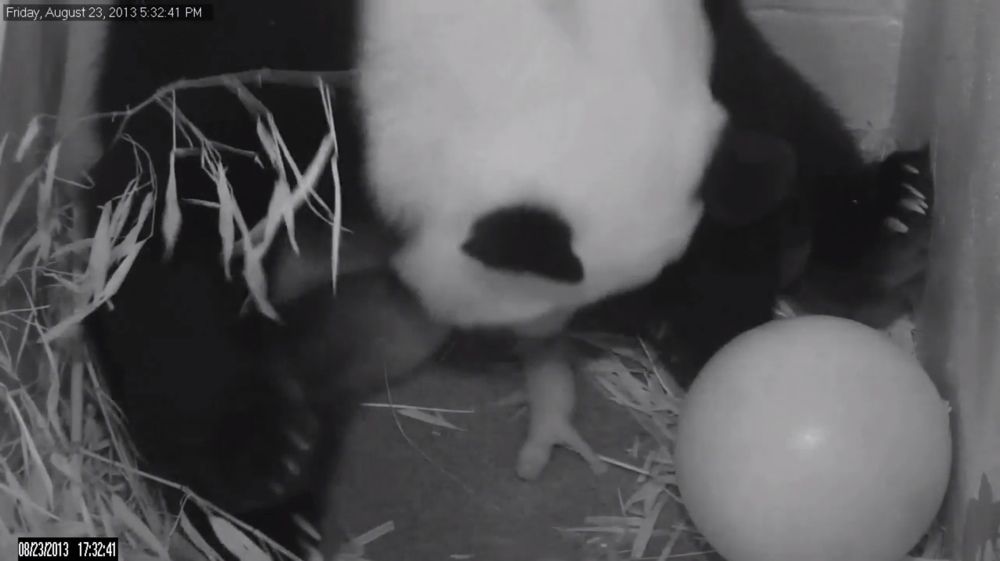It's a Cub! Giant Panda Mei Xiang Gives Birth at National Zoo

The giant panda Mei Xiang has become a proud mama, again, giving birth to a cub today (Aug. 23) at 5:23 p.m. ET at the Smithsonian's National Zoo in Washington, D.C.
Using the panda cams, zoo workers have been monitoring Mei Xiang (may-SHONG) every day, all day, since Aug. 7. And then at 3:36 p.m. ET today her water broke and the giant panda began having contractions
"I'm glued to the new panda cams and thrilled to hear the squeals, which appear healthy, of our newborn cub," said Dennis Kelly, director of the Smithsonian's National Zoo. "Our expansive panda team has worked tirelessly analyzing hormones and behavior since March, and as a result of their expertise and our collaboration with scientists from around the world we are celebrating this birth." [See Photos of Mei Xiang and Her Cub]
After natural breeding attempts between Mei Xiang and the zoo's male panda Tian Tian were unsuccessful, the female was artificially inseminated twice on March 30.
Determining whether Mei Xiang (or any female giant panda) was pregnant was nearly impossible, as females often experience a pseudopregnancy in which they show all the signs of a real pregnancy; their hormone levels surge, they build nests, lose their appetites and sleep more than usual. Indeed, Mei Xiang's appetite had been steadily decreasing and she was spending more time in her den, zookeepers said.
In addition, giant panda fetuses don't begin developing until the last few weeks of gestation. Zookeepers had confirmed a rise in Mei Xiang's progesterone levels on July 10, suggesting she would either give birth in the following 40 to 55 days or her pseudopregnancy would come to an end.
"The only definitive way to determine if a female is pregnant before she gives birth to a cub is to detect a fetus on an ultrasound," zookeepers wrote on the zoo's giant panda blog. "Mei Xiang's last ultrasound was August 5, during which veterinarians saw no evidence of a fetus."
Sign up for the Live Science daily newsletter now
Get the world’s most fascinating discoveries delivered straight to your inbox.
The cub, whose sex has yet to be determined, will get its first health checkup in the next couple of days, with follow-up exams every few days during the next week.
Scientists will also perform a paternity test on the cub as not all of the semen came from Tian Tian. Whereas the first insemination involved fresh semen and frozen semen collected in 2003, all from Tian Tian, the second insemination used a mix of Tian Tian's frozen semen and frozen semen collected from Gao Gao, of the San Diego Zoo, in 2003.
Mei Xiang is not a first-time mom. She gave birth to Tai Shan in 2005 after artificial insemination. Tai Shan now lives at the Panda Base in BiFengxia in Ya'an, China. (All pandas officially belong to China under international law.) Mei Xiang's second cub didn't make it; the little one was born on Sept. 16, 2012 after artificial insemination, and six days later the giant panda baby died from liver damage due to underdeveloped lungs, zookeepers said.
Follow Jeanna Bryner on Twitter and Google+. Follow us @livescience, Facebook & Google+. Original article on LiveScience.com.
Jeanna Bryner is managing editor of Scientific American. Previously she was editor in chief of Live Science and, prior to that, an editor at Scholastic's Science World magazine. Bryner has an English degree from Salisbury University, a master's degree in biogeochemistry and environmental sciences from the University of Maryland and a graduate science journalism degree from New York University. She has worked as a biologist in Florida, where she monitored wetlands and did field surveys for endangered species, including the gorgeous Florida Scrub Jay. She also received an ocean sciences journalism fellowship from the Woods Hole Oceanographic Institution. She is a firm believer that science is for everyone and that just about everything can be viewed through the lens of science.











